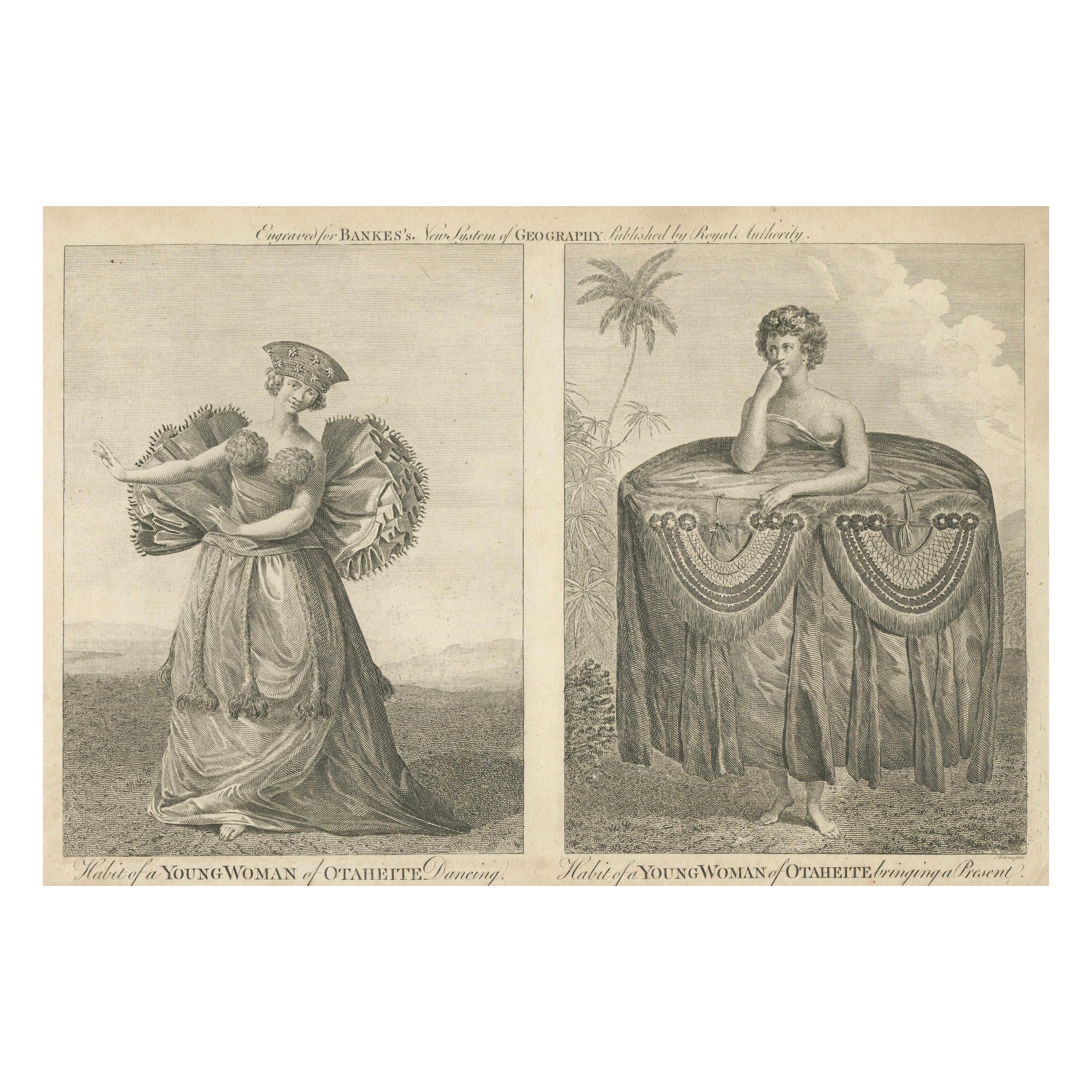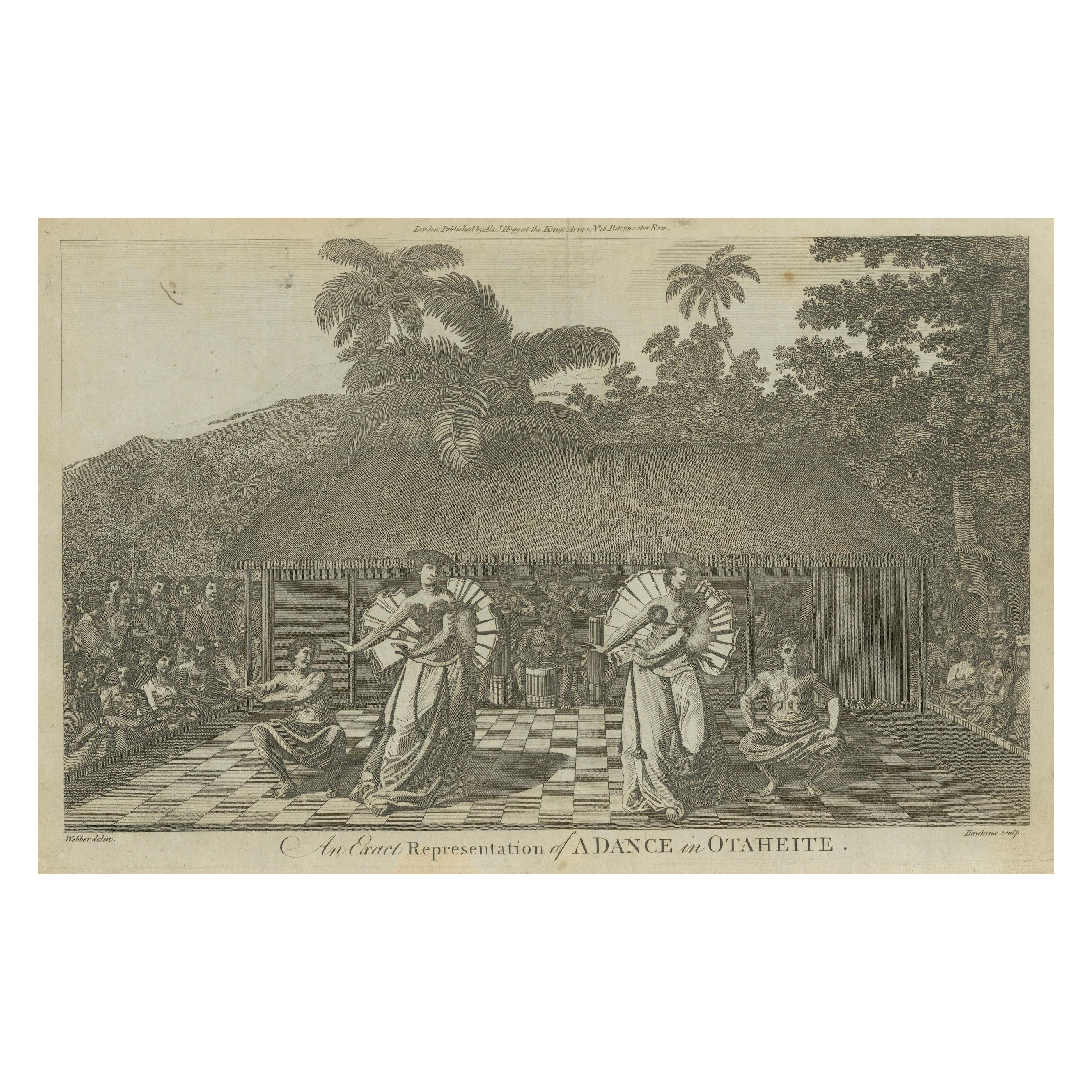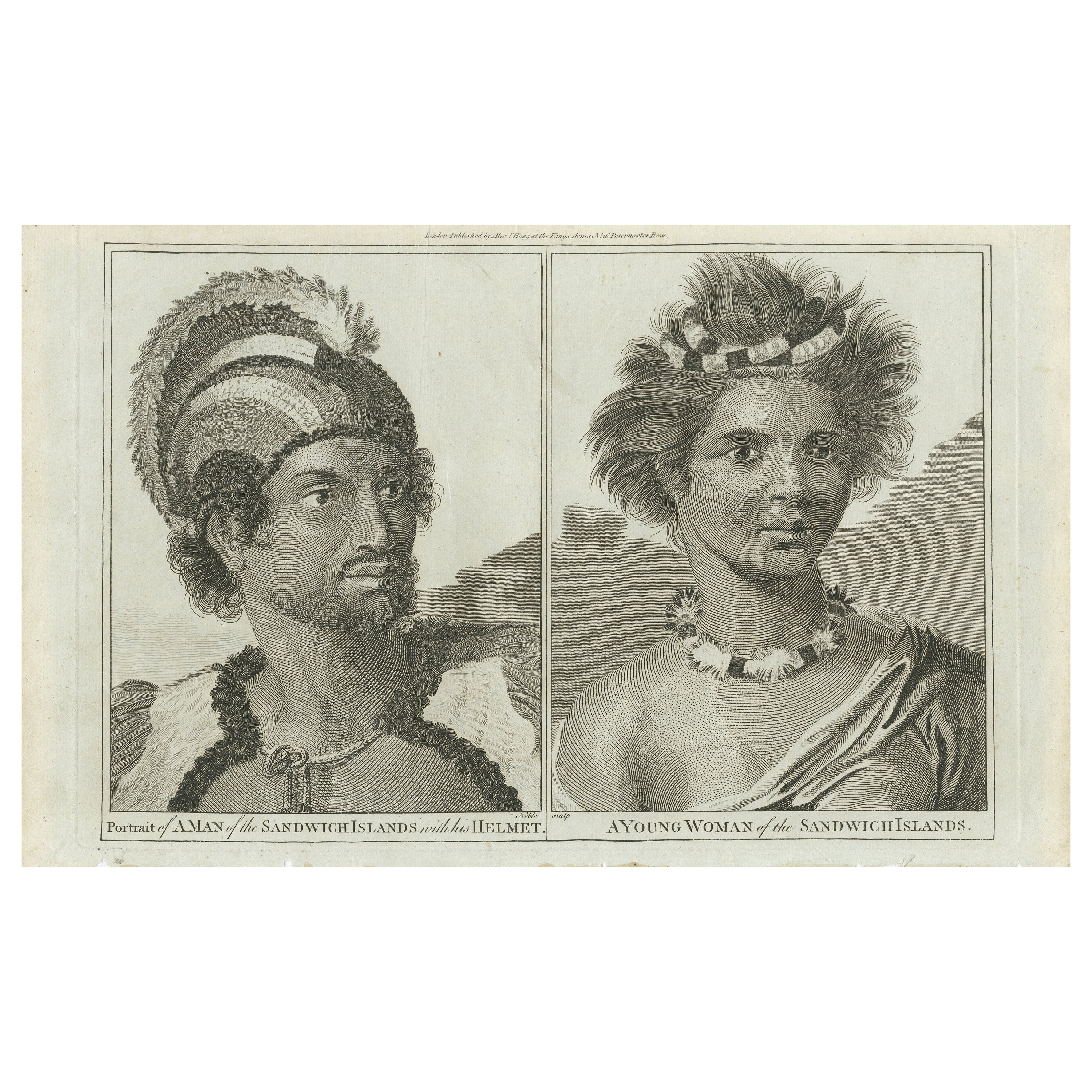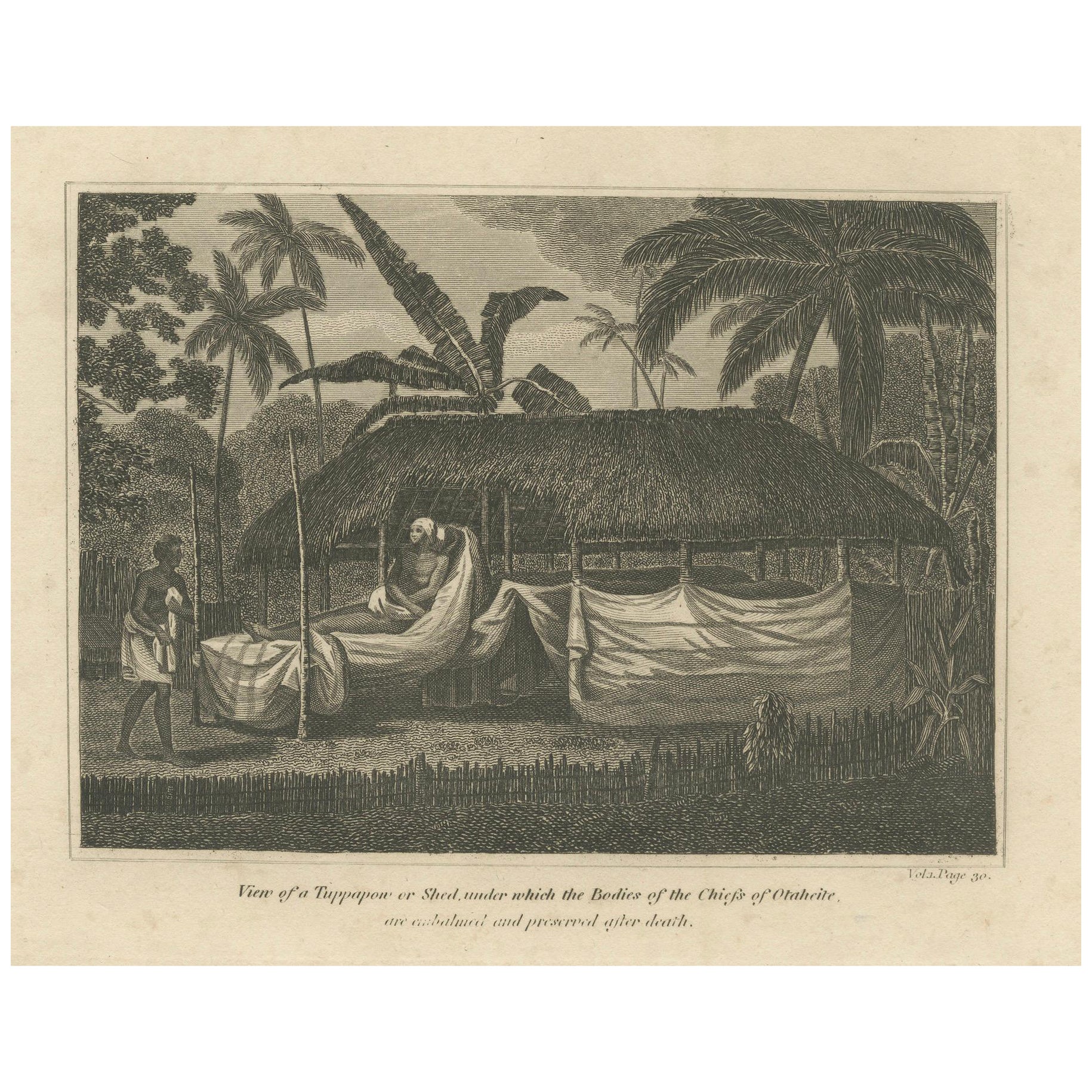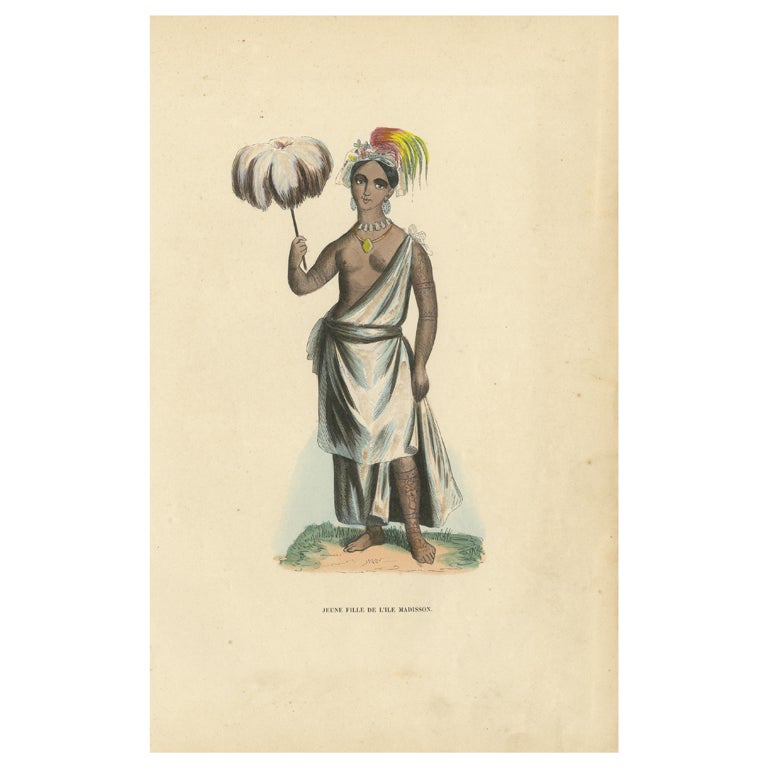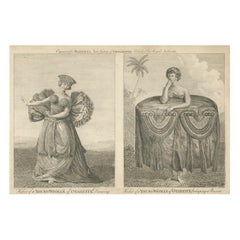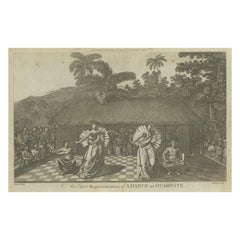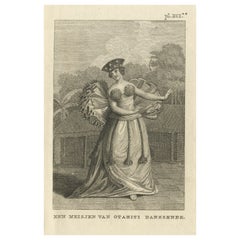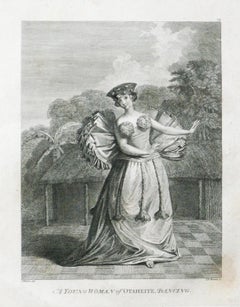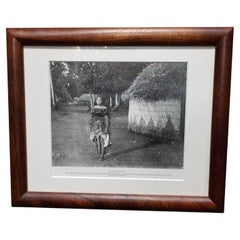Items Similar to Ceremonial Grace: The Gift-Bearing Attire of a Tahitian Woman in 1799
Want more images or videos?
Request additional images or videos from the seller
1 of 6
Ceremonial Grace: The Gift-Bearing Attire of a Tahitian Woman in 1799
$330.81
$413.5120% Off
£247.96
£309.9520% Off
€280
€35020% Off
CA$454.47
CA$568.0920% Off
A$507.38
A$634.2220% Off
CHF 265.86
CHF 332.3220% Off
MX$6,210.77
MX$7,763.4720% Off
NOK 3,376.39
NOK 4,220.4920% Off
SEK 3,183.51
SEK 3,979.3820% Off
DKK 2,131.46
DKK 2,664.3320% Off
Shipping
Retrieving quote...The 1stDibs Promise:
Authenticity Guarantee,
Money-Back Guarantee,
24-Hour Cancellation
About the Item
Engraved plate by John Webber, titled "A Young Woman of Otaheite, in the dress they assume when bringing a Present."
This work was included in the published account of Captain James Cook's third voyage, which is a significant historical record of the explorations of the Pacific Ocean and its islands during the 18th century.
John Webber served as the official artist on Captain Cook's third voyage, and his drawings are some of the most important visual records we have of the Pacific cultures at that time. His work is noted for its attention to detail and its ethnographic significance, often capturing the dress, customs, and daily life of the people Cook encountered.
The title indicates that the woman depicted is from Otaheite, now known as Tahiti in French Polynesia. It was one of the many islands visited by Cook during his expeditions. The image serves as an important cultural and historical document, giving insight into the attire and customs of Tahitian society at the time. The mention of "the dress they assume when bringing a present" suggests that this particular outfit was worn for specific ceremonial or significant social occasions. The publication date of 1799 indicates that this engraving was made some years after Cook's voyage, which ended with his death in 1779.
- Dimensions:Height: 10.63 in (27 cm)Width: 8.27 in (21 cm)Depth: 0 in (0.02 mm)
- Materials and Techniques:Paper,Engraved
- Period:
- Date of Manufacture:1799
- Condition:Good condition. Some minor wear due to age and handling. Wear and brown spots around the edges, but the image mostly intact. Overall a wonderful patina and ideal for framing. Study the image carefully.
- Seller Location:Langweer, NL
- Reference Number:Seller: BG-13597-331stDibs: LU3054337767262
About the Seller
5.0
Recognized Seller
These prestigious sellers are industry leaders and represent the highest echelon for item quality and design.
Platinum Seller
Premium sellers with a 4.7+ rating and 24-hour response times
Established in 2009
1stDibs seller since 2017
2,511 sales on 1stDibs
Typical response time: <1 hour
- ShippingRetrieving quote...Shipping from: Langweer, Netherlands
- Return Policy
Authenticity Guarantee
In the unlikely event there’s an issue with an item’s authenticity, contact us within 1 year for a full refund. DetailsMoney-Back Guarantee
If your item is not as described, is damaged in transit, or does not arrive, contact us within 7 days for a full refund. Details24-Hour Cancellation
You have a 24-hour grace period in which to reconsider your purchase, with no questions asked.Vetted Professional Sellers
Our world-class sellers must adhere to strict standards for service and quality, maintaining the integrity of our listings.Price-Match Guarantee
If you find that a seller listed the same item for a lower price elsewhere, we’ll match it.Trusted Global Delivery
Our best-in-class carrier network provides specialized shipping options worldwide, including custom delivery.More From This Seller
View AllCultural Habits of Tahitian Women: Dance and Ceremony, circa 1790
Located in Langweer, NL
This engraving is titled "Habits of a Young Woman of Otaheite", and it was produced as part of Bankes's New System of Geography, which was a popular geographical work published in th...
Category
Antique 1790s Prints
Materials
Paper
$151 Sale Price
20% Off
Celebration of Tahitian Culture: Traditional Dance at Otaheite, circa 1785
Located in Langweer, NL
An antique engraving depicting a dance scene titled "An Exact Representation of a Dance in Otaheite," Otaheite being an archaic name for Tahiti in French Polynesia. This engraving would have been created as a part of a series to document the culture and life of the Tahitian people, likely observed by European explorers during one of the many voyages to the South Pacific in the 18th century.
In the foreground, there are central figures engaged in a dance, wearing traditional Polynesian attire, which includes wraps around their waists and adornments that seem to represent status or a part of the dance costume. They are holding what appear to be fans, which may be part of the traditional dance. The dancers' poses suggest movement and a performance aspect to the scene.
Behind the dancers, we can see a group of musicians providing the accompaniment, playing drums, which indicates the importance of music and rhythm in the dance. To the right, there is an audience of seated individuals, likely members of the community, watching the performance.
The background of the scene includes thatched huts and a lush landscape with palm trees, depicting a typical village setting in Tahiti. The checkerboard pattern on the ground where the dance takes place is notable, as it adds a sense of structure to the scene.
This image would have been intended for a European audience unfamiliar with Tahitian culture and would have served as a visual record of the encounters between European explorers and the peoples of the Pacific Islands.
The engraving you've uploaded, titled "An Exact Representation of a Dance in Otaheite," is likely from a work documenting the voyages of Captain James Cook, given the style and subject matter. Captain Cook made three voyages to the Pacific Ocean during the 18th century, and his encounters with the peoples of the Pacific, including those of Tahiti (Otaheite), were extensively recorded and published.
The engravings from Cook's voyages were made by artists who accompanied him, such as John Webber on his third voyage, or were based on sketches made by other crew members. These images were then published in the official accounts of the voyages. The most notable of these accounts is "A Voyage to the Pacific Ocean" undertaken during Cook's third voyage from 1776 to 1780, which was published in the years following his death in 1779.
Another possible source for this engraving could be from the accounts of Joseph Banks. Banks was a naturalist who joined Cook on his first voyage (1768-1771) aboard the HMS Endeavour and was responsible for extensive collections and descriptions of Pacific cultures. His collections and later works also included illustrations and engravings of the scenes and peoples encountered.
Given that the engraving is labeled as "London Published as the Act directs by Alexr. Hogg at the Kings Arms...
Category
Antique 1780s Prints
Materials
Paper
$94 Sale Price
20% Off
Antique Print of Dancing Girl of Otahiti or Tahiti by Cook, 1803
By James Cook
Located in Langweer, NL
Antique print titled 'Een Meisjen van Otahiti danssende'. Antique print depiciting a female native of Tahiti, dancing. Originates from 'Reizen Rondom de Waereld door James Cook (..)'...
Category
Antique 19th Century Prints
Materials
Paper
$226 Sale Price
20% Off
Regalia of the Sandwich Islands: Portraits in Traditional Attire, 1790
Located in Langweer, NL
This engraving, published in London by Alex Hogg at the Kings Arms, No.16 Paternoster Row, features two side-by-side portraits with the labels "Portrait of ...
Category
Antique Late 18th Century Prints
Materials
Paper
$321 Sale Price
20% Off
Tee's Eternal Rest: The Embalmed Chief of Otaheite or Tahiti, circa 1800
Located in Langweer, NL
Title: "Tee's Eternal Rest: The Embalmed Chief of Otaheite"
Description: This engraving, after a drawing by John Webber, depicts the preserved body of Tee, a chief from Otaheite (Tahiti), following his death. The artwork originates from an account of Captain James Cook's third voyage and showcases the practice of preserving the dead in Tahitian culture. The scene takes place in Matavai Bay, a significant location during the era of exploration, already famed through earlier visits and the engravings of Sydney...
Category
Antique Early 19th Century Prints
Materials
Paper
$226 Sale Price
20% Off
Free Shipping
Old Print of Piteenee, a Young Woman of Nuku Hiva, Marquesas Islands, 1845
Located in Langweer, NL
Antique print titled 'Jeune Fille de l'Ile Madisson'. Hand colored woodcut of Piteenee, a young woman of Nuku Hiva, Marquesas Islands (French Polynesia). She wears a white gown, cowrie necklace...
Category
Antique Mid-19th Century Prints
Materials
Paper
$160 Sale Price
20% Off
You May Also Like
A Young Woman of Otaheite, Dancing (Tahiti) 1784 Captain Cooks Voyage by Webber
By John Webber
Located in Paonia, CO
A Young Woman of Taheite Dancing (Tahiti) is from the 1784 First Edition Atlas Accompanying Capt. James Cook and King; Third and Final Voyage of Captain James Cook.John Webber (1752-...
Category
1780s Realist Figurative Prints
Materials
Engraving
18th Century Framed Fashion Engraving
Located in Vista, CA
18th century framed fashion engraving of a woman dressed for entertaining or to be entertained, with a plume feather hat, a fancy bustle with gree...
Category
Antique 18th Century European Drawings
Materials
Glass, Paper, Wood
Victorian Pacific Island Beauty "A Samoan Belle" Lithograph in Koa Frame
Located in Van Nuys, CA
Museum Quality Photographic Lithograph Artwork print titled "A Samoan Belle" depicting a beautiful Victorian-era Samoan woman in traditional dress with her village in the background....
Category
1990s American Prints
Materials
Paper
$137 Sale Price
44% Off
Queen of Rewa, 19th century Fiji portrait engraving print
Located in Melbourne, Victoria
'Queen of Rewa'
Portrait of seated Fijian woman, draped from the waist in tapa cloth, holding a fan, wearing jewelry and an elaborate headdress.
From Narrative of the United States...
Category
Mid-19th Century Naturalistic Portrait Prints
Materials
Engraving
"A Dance in Otaheite" (Tahiti), Engraving from Captain Cook's 3rd Voyage
By John Webber
Located in Alamo, CA
"A Dance in Otaheite" (Tahiti) is an engraving created by William Sharp (1749-1824), from a drawing by John Webber (1752-1793), who was the artist on Captain James Cook's 3rd and final voyage of discovery. It is a plate in the atlas of "A Voyage to the Pacific Ocean Undertaken by the Command of His Majesty, for Making Discoveries in the Northern Hemisphere", the official British Admirality sanctioned journal published upon completion of the voyage in London in 1784 by Strahan & Cadell.
Two women and two men wearing ceremonial costumes, performing a dance outdoors standing on a mat. Three men are playing the drums in the background, in front of a thatched roof building. An audience of men are sitting on both sides of the stage. By the time Webber arrived in Tahiti, 'south sea' imagery had become familiar. Webber gave concentrated attention to dance. He had the opportunity to distinguish the Tahitian dance from the more formalized dancing of Tonga. Whereas they seem to have called to mind the more formal dances of antiquity, the Tahitian dancing aroused memories of peasant and folk dancing.
This engraving is professionally framed in Koa wood. Koa wood is legendary in Hawaii. Not only is this amazing wood native to Hawaii, but it is known for the deep rich colors and varied grain pattern. Koa has an honored heritage in Hawaii and is highly revered and sacred. The word “koa” means “warrior” in Hawaiian. The warriors of King Kamehameha the Great, created canoes and weapons from a wood plentiful on the Big Island of Hawaii. This wood became synonymous with the warriors themselves, and it became known as koa.
The print is in excellent condition.
There are three other engravings listed from the official journal of Captain Cook's 3rd voyage available that are presented in identical Koa wood frames and double mats (LU117324682432, LU117324684052, LU117324684062). They would make a wonderful grouping for a display of 2, 3 or 4 prints. A discount is available for a grouping depending on the number of items included.
Hawaii was discovered by Captain Cook during this voyage. Hawaii was originally called The Sandwich Islands in honor of The Earl of Sandwich...
Category
1780s Realist Landscape Prints
Materials
Engraving
Original Antique Print of The Greek Goddess, Hebe. Dated 1833
Located in St Annes, Lancashire
Wonderful image of Hebe
Fine steel engraving.
Published by Fisher. Dated 1833
Unframed.
Category
Antique 1830s English Neoclassical Prints
Materials
Paper
More Ways To Browse
Syria Jewelry
Tall Mid Century Modern Buffet
Tall Narrow Shelves
Tamil Nadu
Terracotta Sink
Thai Bamboo
Thai Dragons
Thai Statue Wood
Tibetan Buddha Statue
Tiffany Glass Mirror
Tin Horse
Tubular Chrome Shelf
Unglazed Clay Jar
Used Metal Storage Bins
Vaseline Uranium Glass
Versaille Urns
Vintage 329
Vintage Banana Leaf
